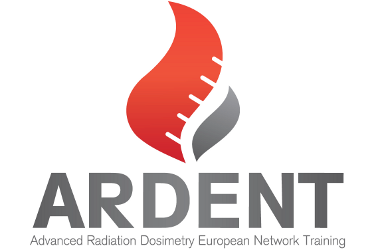ESR 7 - Log Records of my activities througout the ARDENT training
Activities on the 4th Quarter of 2013
November-December 2013
Experimental activities
Date: December, 2013
Training on skills for the assembly and characterization of the Timepix detection units for the ATLAS-MPX network upgrade: The upgrade of the ATLAS-MPX network to ATLAS-TPX consists on positioning 16 new Timepix-based detection units at strategic points inside and surrounding the ATLAS experiment at the LHC. As part of my tasks, I will assemble and characterize (equalize, calibrate in different radiation fields, etc.) all units, which basically consist on special arrays of two Timepix sensors with different thicknesses (300 and 500 ums.) facing each other, with a set of neutron convertor sections in between, and read-out by a common interface.
As a first step, I learned how to do the whole assembly of each layer, isolated components from the converters' frame and solded elements on the chipboards.

Meanwhile, I also learned how to wire-bond sensors from the chipboard to the chip itself.
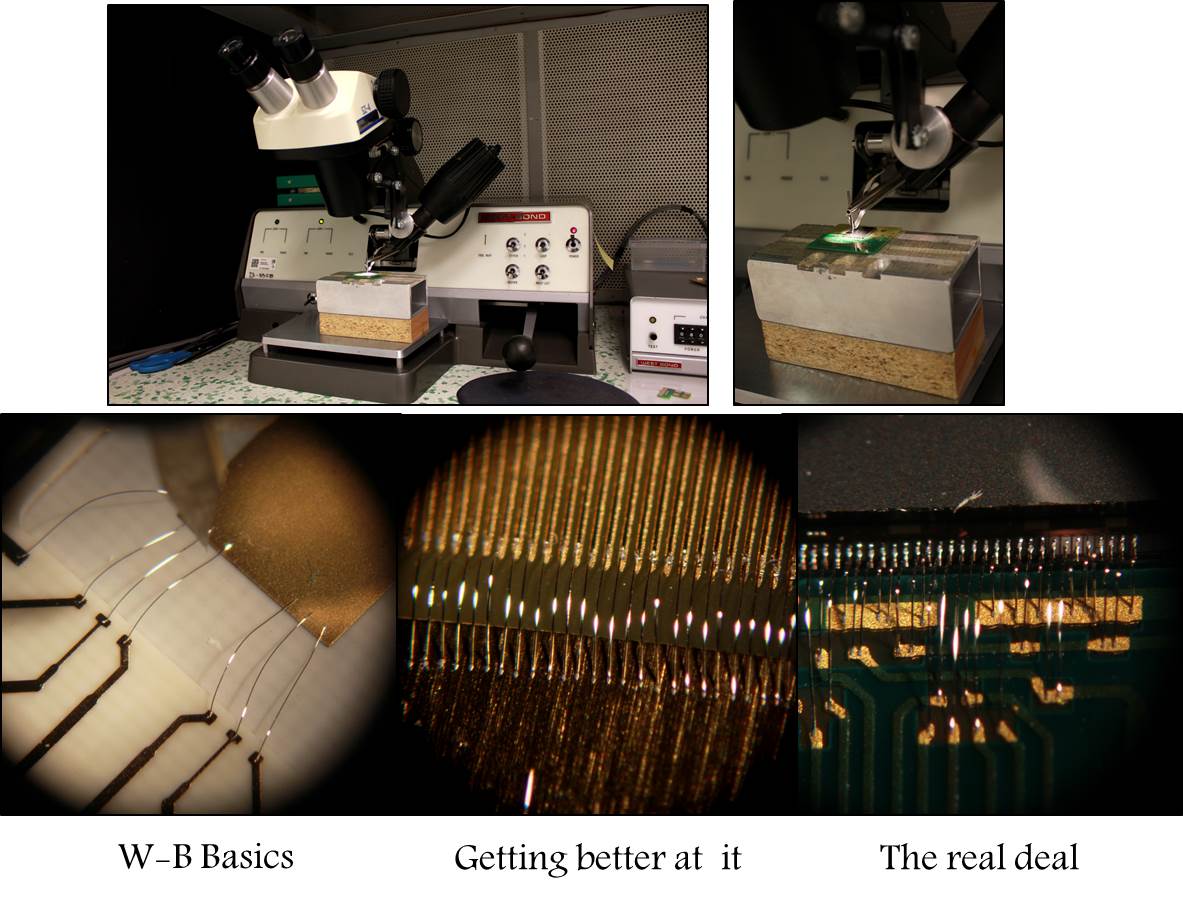
And I got assigned my first USB read-out interface, which is a redesign of FITPix and had to be baptized provisionally:

It is still a long way to the top: Many sensors to deal with and a lot of testing and parameter setting for the whole network.
Date: November 7-12, 2013
Tests of the RISESAT micro-tracker EM at the IEAP Van de Graff accelerator: The Engineering Model of the Timepix-based micro-tracker to be placed at the RISESAT satellite in the following months (https://directory.eoportal.org/web/eoportal/satellite-missions/r/risesat) was taken to the VdG accelerator in order to evaluate its performance during long-term irradiation with neutrons and protons with energies in the range of MeV, and the coincidence between its two different layers. After data acquisition, the coincidence efficiency was quantified and some slight software and hardware issues were identified and corrected with the help from collaborators at the IEAP.
Here I show some photos of the setup and a pair of acquisitions from both layers working in Time of Arrival mode:

Date: December 2-6, 2013
New equalization for the EM: After some tests with the previous configuration, we decided to equalize both layers of the micro-tracker for a second time. Due to the requirements of the RISESAT Satellite the read-out interface is different from the one of a regular MPX, therefore, I had to learn how to change the EM firmware using an additional bridge device in order to be able to read the layers and do the equalizations through an USB connection and using Pixelman.
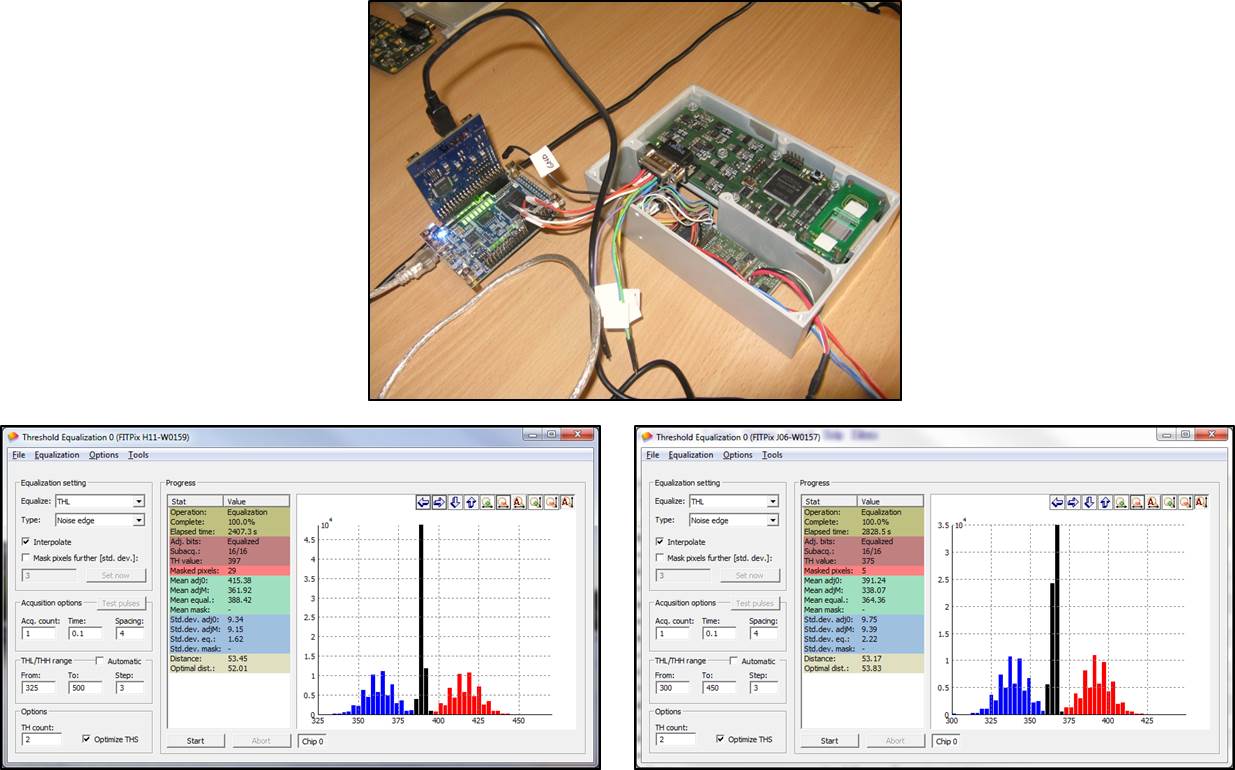
Date: November, 2013
Coincident Timepix devices in a 11B(p,Alpha)Alpha+Alpha reaction: Coincident Timepix devices operating with a "Mixed Mode" mask (One of every nine pixels was working in ToA mode, the other eight in TOT) were used to measure at different angles from the interaction point of a 11B(p,Alpha)Alpha+Alpha reaction in order to test the performance of such setting for this type of measurements. I analyzed data from different configurations based on the experience from my Master's Thesis.
Here I show some photos of the setup (As measured by Dr.Ing. Carlos Granja from the IEAP of the CTU) and some preliminary data analysis:

Date: December, 2013
Access to data from Timepix devices at the ISS and Proba-V Satellite (SATRAM): I learned how to access the daily updated data from five Timepix devices at the ISS and one at the SATRAM unit at Proba-V Satellite.
Even though it is exciting and promising to have access to this data, and I understand the events that they are detecting from my previous experience with Timepix detectors...I still have a lot to learn about radiation in space in order to analyze this data properly.
The Truth is -already- Out There:
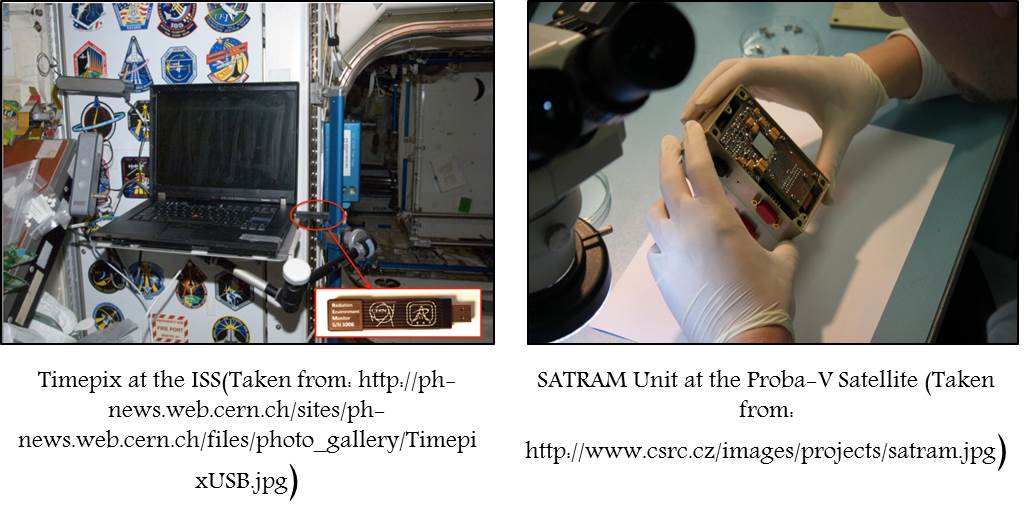
Activities on the 1st Quarter of 2014
January-March 2014
Experimental activities
Date: January-March, 2014
Assembly, characterization and calibration of the ATLAS-TPX devices: This quarter was mainly dedicated to tune and study all the parameters for an optimal and long-term operation of all the radiation-hard devices inside the ATLAS cavern for the next years.
A proper selection of sensors was made, and after their equalization their noise level was revised and improved.
At the end of January, a measurement campaign at the Heidelberg Ion Therapy Center was carried out in collaboration with ESR9 and other colleagues from the IEAP during beamtime provided by ARDENT. In that opportunity, the performance, synchronization and tracking capabilities of the ATLAS-TPX (specially focusing on its operation in "Time of Arrival"mode) were tested for protons, helium, carbon and oxygen ions with energies in the range from 80 to 430 MeV per nucleon and at different incidence angles. CR39 detectors were placed close to the sensors for intercomparison.
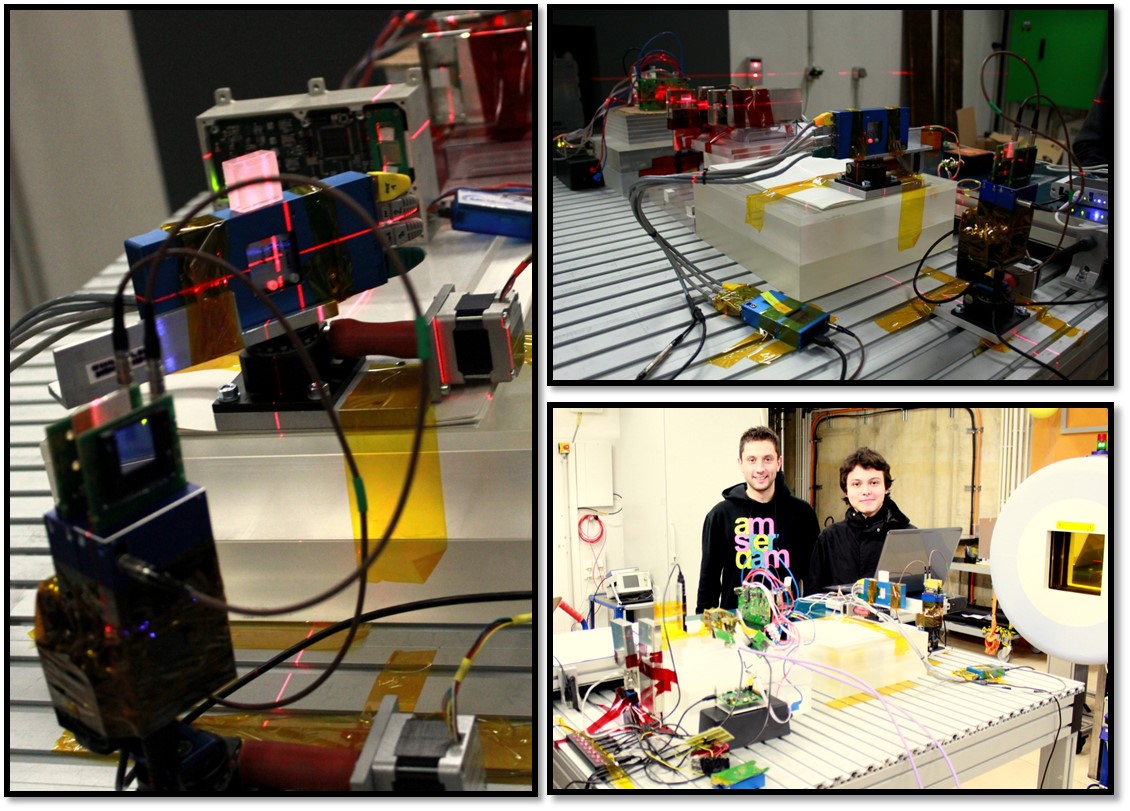

Regarding the energy calibration of all detectors, fluorescence x-rays from three different materials and one radioactive AmIn source were used. Energy peaks and detector thresholds were chosen to suit the design of the devices and all variables involved in a long-term operation inside the intense radiation field at the ATLAS experiment. The following figures show the setup and calibration validation with different sources.
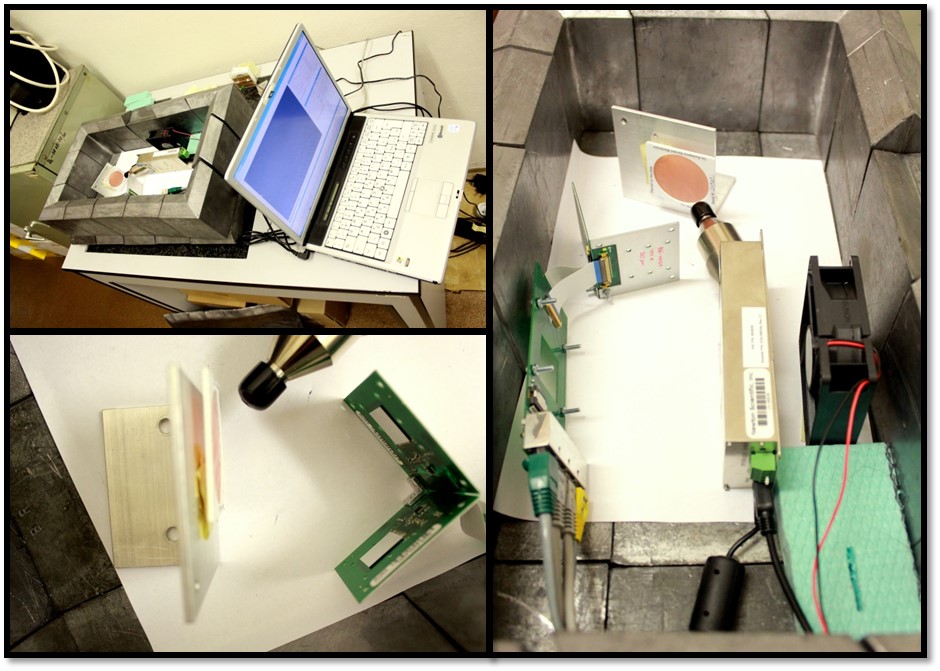

In parallel, different methods were tested for the deposition of Lithium Fluoride used as thermal neutron convertor in between sensors. After choosing the most efficient technique, LiF was deposited and weighted for all devices.

Date: January, 2014
Tests of the RISESAT micro-tracker EM: The RISESAT device was exposed to an Americium source in vacuum and ion beams at the Heidelberg Ion Therapy Center in both Time Of Arrival and Time Over Threshold mode.
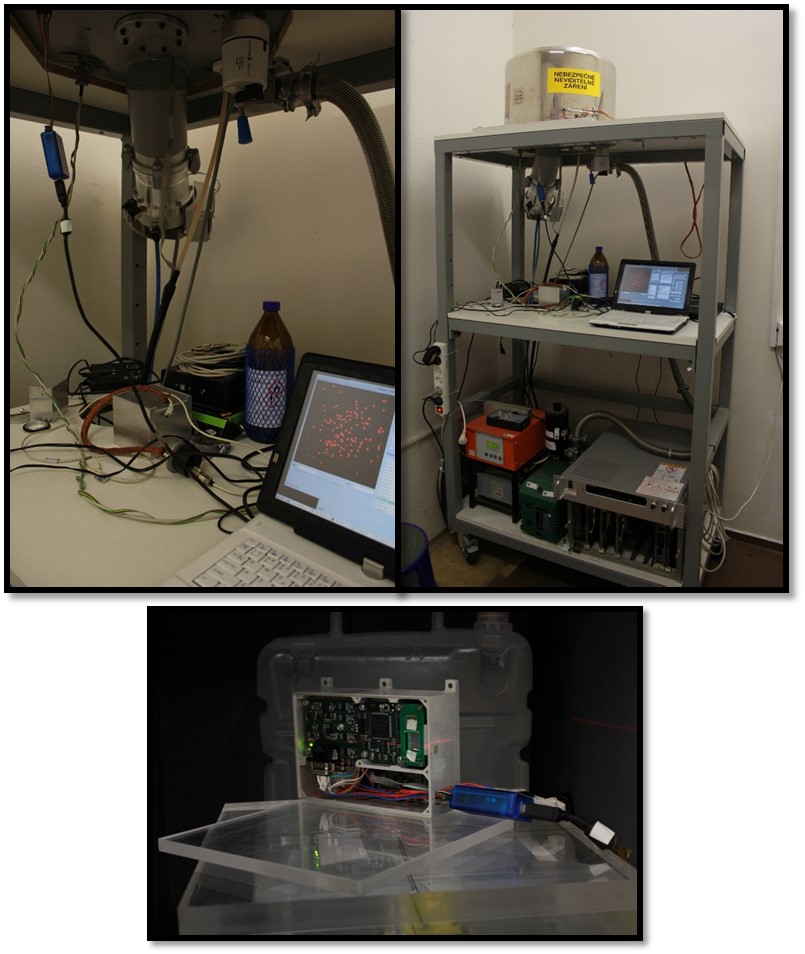
Final device: The final design of the RISESAT micro-tracker is already available. It overcomes flaws identified at the EM stage. Its characterization and calibration will be performed in the future.
Activities on the 2nd Quarter of 2014
April-June 2014
Experimental activities
Date: April-June, 2014
Acquisition of data for all energy calibrations and other reference measurements: X-ray data acquisition for the calibration of all devices was finished in cooperation with ESR8. In addition, I/V measurements to estimate the leakage current of the assemblies and reference measurements of alpha particles were performed for intercomparison of the final calibrations from all devices.

Radiation hardness test at the Nuclear Science Institute, Rez (Czech Republic): Some partially malfunctioning Timepix sensors were assembled as an ATLAS-TPX device to perform a preliminary radiation hardness test of the devices when irradiated in a synchrotron facility at the Czech Nuclear Science Institute. .
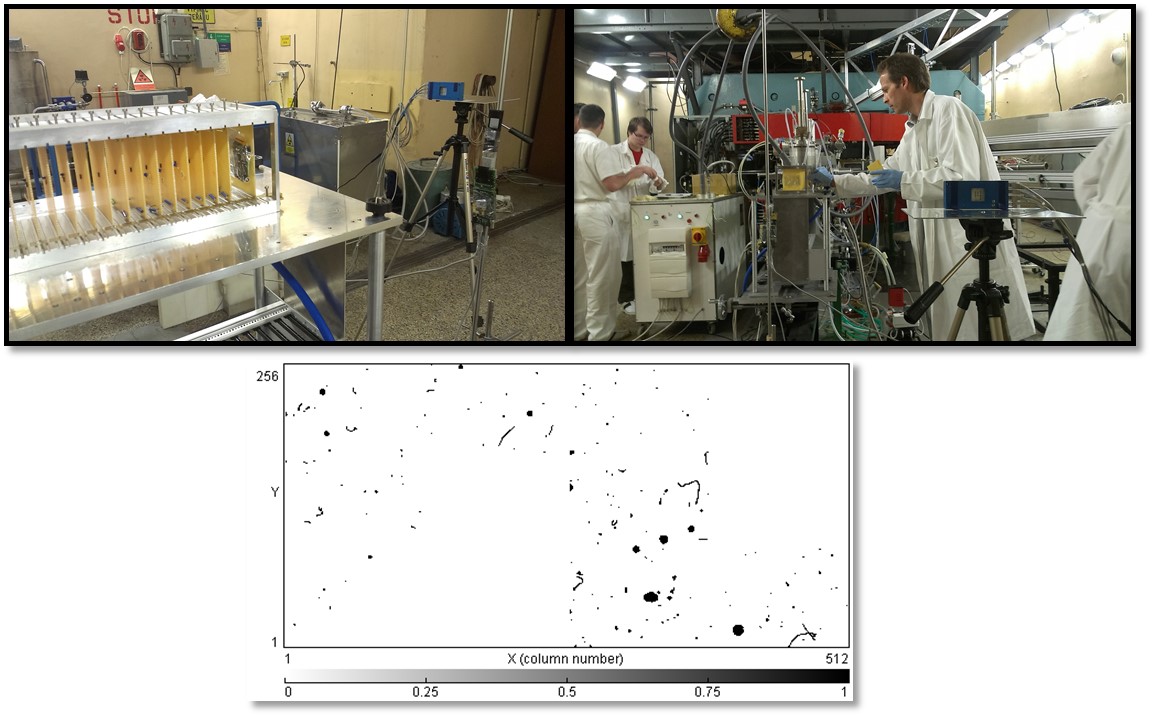
Neutron Efficiency calibrations: All ATLAS-TPX devices were irradiated on both sides by thermal and fast neutrons from 241Am and 252Cf sources to determine the efficiency of convertor areas for neutron detection up to 4 MeV in each detector.

Sixteen ATLAS-TPX devices were taken to CERN for their installation inside the ATLAS cavern. One additional device is kept at the IEAP in Prague as reference for testing, evaluation of effects of future changes on operation conditions, and further characterization measurements which could be extrapolated to other devices.
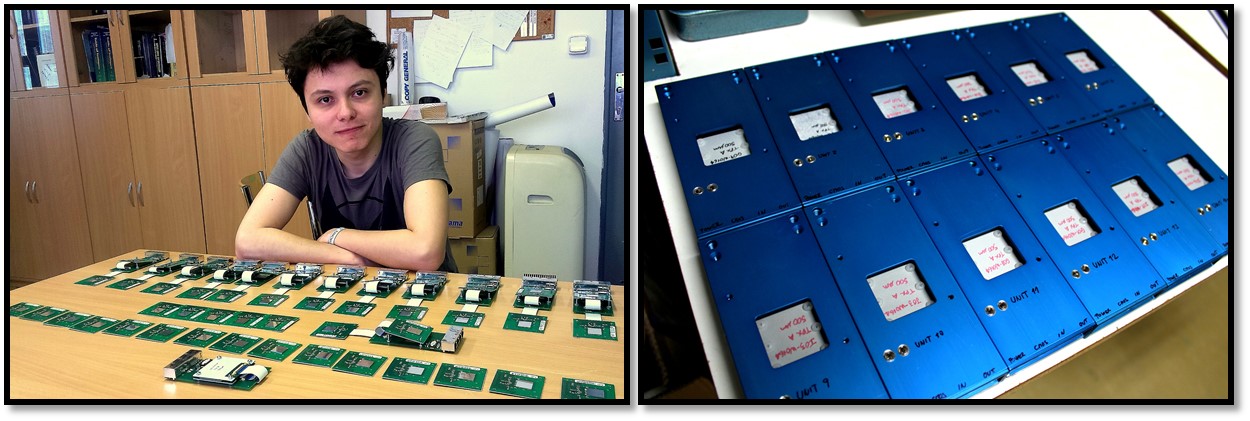
...This is just starting.
Date: April 2014:
Measurements at the Heidelberg Ion Therapy Center: Support on the planning and execution of preliminary tests for a Timepix-based magnetic spectrometer. In addition, one ATLAS-TPX unit was placed as a parasite device during the measurements with different types of ions in order to test its behaviour after changes in the interface firmware and detector settings.

Date: February and May/June 2014
Introducing new researchers to the operation of Timepix devices: I trained PhD students from the University of Wollongong (Valentina Giacometti, Italian) and University of Montreal (Thomas Billoud, French) who visited the IEAP in Prague to learn about the capabilities, operation and calibration of Timepix devices. This experience will be helpful to their future research on proton therapy and monitoring of luminosity inside the ATLAS experiment.
p>Date: May 2014ARDENT training course: I attended a one-week training course organised for all ARDENT ESR's consisting of three modules: Technology Transfer, Project Management and Entrepreneurship. The first module was given by CERN Knowledge and Technology Transfer group, the second by STS SAUTER Training and Simulation S.A., the third by the Said Business School at Oxford, UK.
Date: May 2014
Outreach activity at the 60th Anniversary celebration of CERN: I was one of the six ARDENT ESRs presenting the Timepix device to visitors at the Radiation Protection stand in the framework of CERN's 60th Anniversary Celebrations.
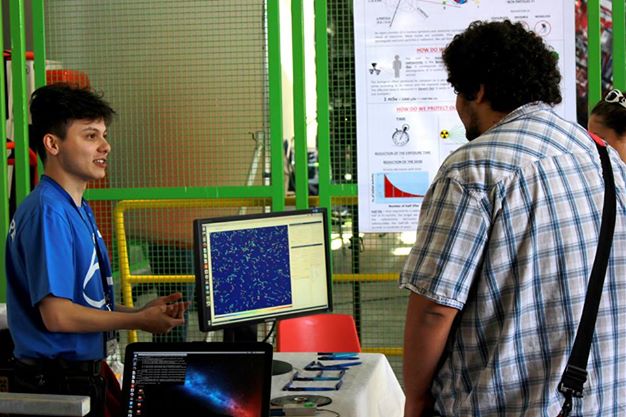
Activities on the 3rd Quarter of 2014
July - September 2014
Activities
Date: 20 - 27 July, 2014
First visit for the installation and test of the ATLAS-TPX devices inside the ATLAS cavern: 12 out of 16 devices were set in the planned positions with the collaboration of colleagues from the IEAP CTU. Cabling was available only for one of them, which was used for testing of operational values in the new dedicated "ATLASPIX" interface.
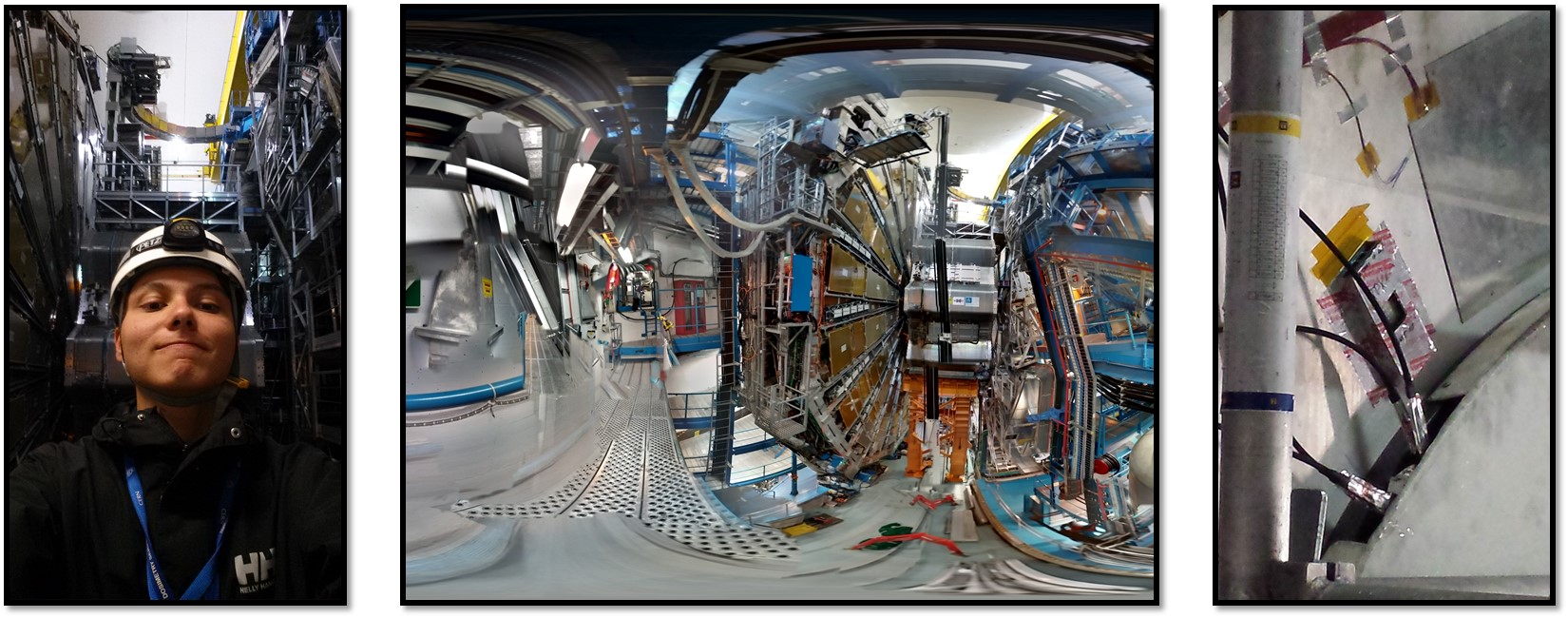
Date: 4 - 5 August, 2014
Measurement at the IEAP VdG accelerator: Together with ESR9, we irradiated the reference ATLAS-TPX device with quasi-monochromatic 16.7 MeV neutrons from a D-T reaction while it rotated from one of its sides to the other one to estimate its detection and geometric efficiencies at this energy level.
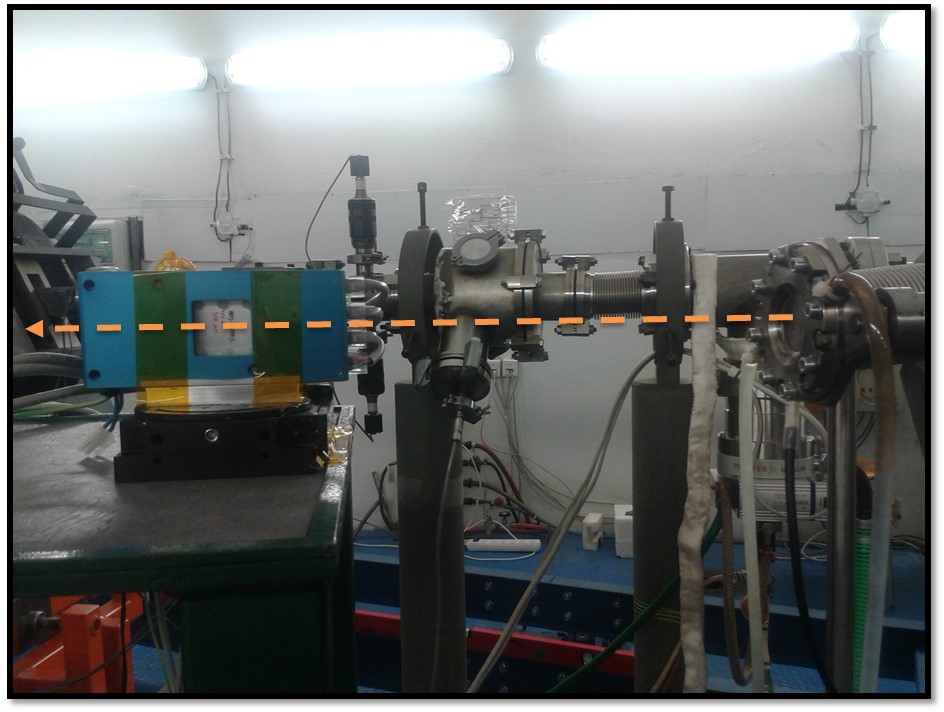
Date: 15 - 21 September, 2014
Second visit for the installation and test of the ATLAS-TPX devices inside the ATLAS cavern: In this ocassion, the cabling for 9 devices was available and it was possible to test their response with a tuned prototype of the dedicated interface.

Date: 30 June - 4 July 2014
NDRA 2014, Summer School on Neutron Detectors and Related Applications: I attended this Summer School organized by the Industrial Engineering Department of the University of Trento. The aim of the school was to illustrate principles, methodologies and the most recent applications of neutron detection technologies. In particular, the school dealt with neutron-matter interaction principles suitable to neutron detection, materials for neutron detectors, signal processing, Monte Carlo simulation codes and interdisciplinary applications of neutrons.
Date: 10 - 22 August, 2014
Wilhelm and Else Heraeus Physics School on "Ionizing Radiation and Protection of Man": This Physics School (Organized by the German Physics Society and the Helmholtz Institute Munchen) consisted on classes and some practical activities about three main topics: "Radiation Physics and Dosimetry", "Radioecology", and "Radiation Epidemiology" focusing at the end on the assessment of Risk vs. Dose factors in different situations. All talks were given by renown scientists on the area of radiation monitoring and regulation from all over the world.
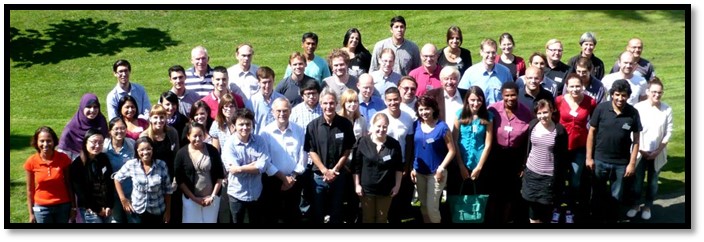
Date: 17 September, 2014
Medipix Meeting at CERN: I attended the Medipix meeting, where I was updated about the status of the Medipix3, Timepix3, Timepix2, read-out interfaces and research projects of other members of the Medipix Collaboration.
Date: 11 - 13 September, 2014
8th European Conference on Medical Physics: I attended this conference organized by the European Federation of Organizations for Medical Physics. Researchers from all over Europe and some research centres and hospitals from the USA presented their contributions in two parallel sessions. My assistance was focused on talks related to Quality Assurance in Radiotherapy, Monte Carlo simulations for Hadron Therapy and Dosimetry. My poster contribution "Characterization of secondary radiation in ion beam therapy using a mixed pixel operation mask" was available all the time in digital form for the participants and I did a short presentation of it in the e-poster presentation section.
Activities on the 4th Quarter of 2014
October - December 2014
Activities
Date: October, 2014
Preparation of detectors for the MoEDAL experiment: Three Timepix detectors equipped with 1 mm thick silicon sensors were characterized and calibrated for a network configuration (Similar to ATLAS-TPX) installed around the interaction point of the MoEDAL experiment at the LHC. One of them was covered with neutron converters and we performed measurements to calculate its efficiency at the Czech Metrology Institute in Prague with thermal and 252Cf neutrons.
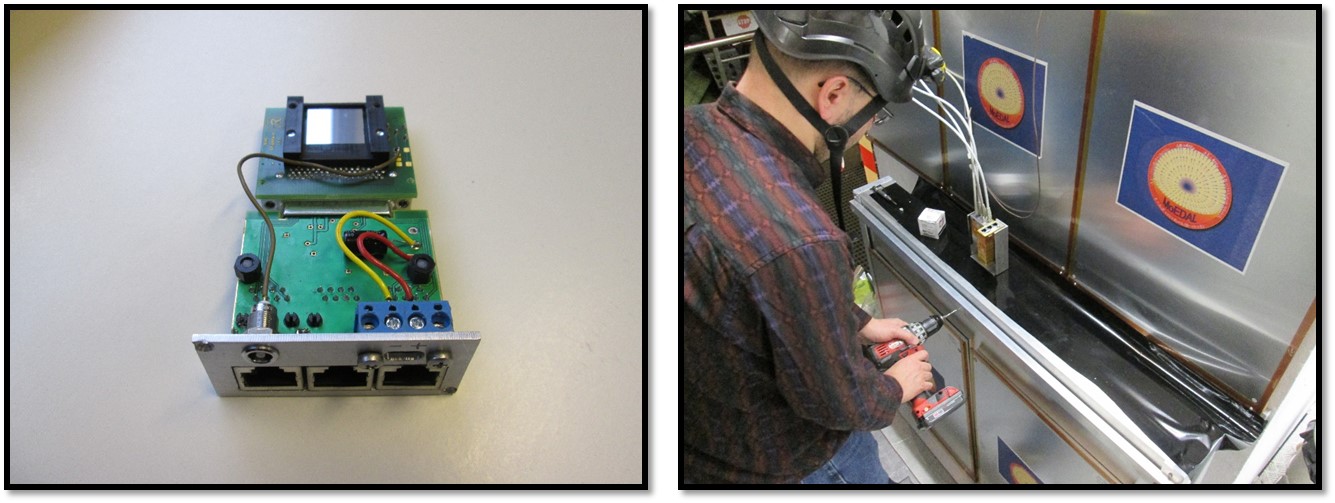
Date: 26 October, 2014
Parasite measurement at the DKFZ: After assisting to a symposium organized by the DKFZ in Heidelberg, I was able to participate as a parasite experiment in a beam time dedicated to the Heavy Ion Therapy group. Together with collaborators from the IEAP CTU, we exposed some Timepix and Timepix3 detectors with unusual sensors to light ion beams.
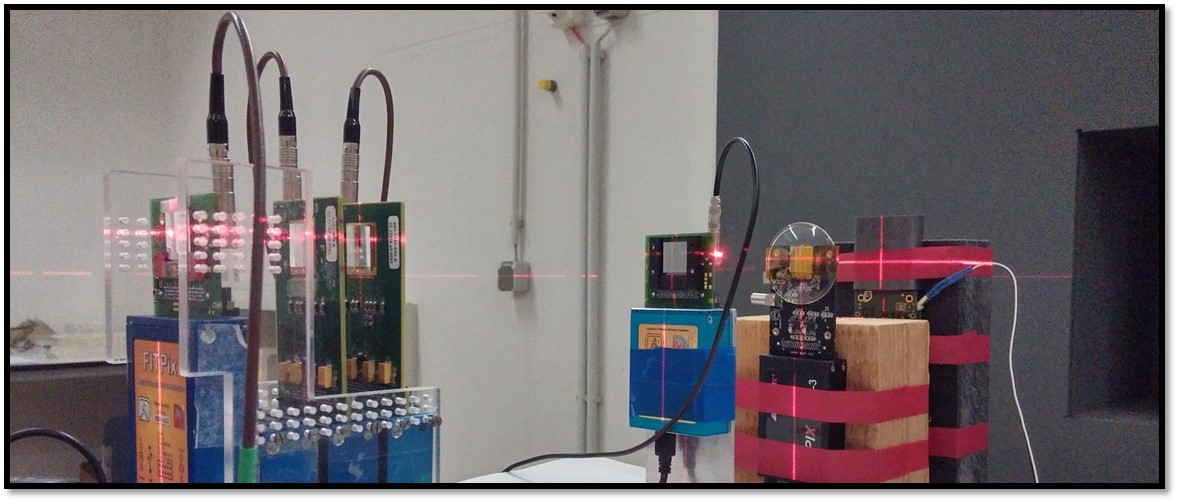
Date: 18 - 30 November, 2014
Tests, characterization and calibration of Timepix3: Timepix3 is a new detector of the Medipix family. It allows simultaneous energy and time of arrival measurements with a higher time resolution than regular Timepix devices. As this is a very new detector, its features are still under test and many things (Even the acquisition software) are under development. Together with ESR9 and ESR2, we worked on the understanding of the data formats from the new software, tested the USB interface, characterized the threshold of the detector and acquired x-ray data that we used to calibrate the response in Time Over Threshold mode for two detectors. These two devices were taken for Time Of Flight measurements at Los Alamos National Science Centre in the United States.
Date: 22 - 25 October 2014
Interdisciplinary Symposium ''Precision, Speed and Flexibility: New radiation detection methods for ion beam radiotherapy'': I attended this symposium together with other colleagues from IEAP CTU. The symposium covered topics in detection techniques for quality assurance of ion beams in ion therapy, visualisation of moving organs, beam monitoring in the patient and spectroscopy of secondary ions for radiobiology. Many results from the collaboration between the Ion Therapy Group at the DKFZ and the IEAP CTU in the application of Timepix detectors for such tasks were presented.
Date: 28 September - 3 October, 2014
3rd ARDENT Meeting and Workshop: This was my first official ARDENT meeting with all other ESRs and members of the boards. In the first two days, Early Stage Researchers (Including myself) presented a report on their activities during the last year in the framework of the ARDENT project. In addition, a poster session was held. During the time spent at IBA, we held practical sessions on Quality Assurance for conventional radiotherapy and radiology (Relative and absolute dosimetry, planning systems, dose monitoring with ionization chambers for x-ray imaging) and attended talks regarding applications of semiconductor detectors in the framework of the aims of the project.

Date: 7 - 17 November, 2014
2014 IEEE Nuclear Science Symposium and Medical Image Conference -21st Symposium on room-temperature semiconductor x-ray and gamma ray detectors-: I attended this conference and presented the contribution "Radiation-Hard Timepix Detector-Based Hodoscope for the Characterization of Harsh Mixed Radiation Environments" in the "Radiation Damage Effects and Radiation Hard devices" poster session of the event. This poster contained information about the coincidence tests, characterization, calibration and neutron detection efficiency of the devices assembled for the ATLAS-TPX network. In addition, I attended interesting talks regarding Medipix devices, testing of CdTe and CZT sensors, instrumentation for space applications and pixel semiconductor detectors.
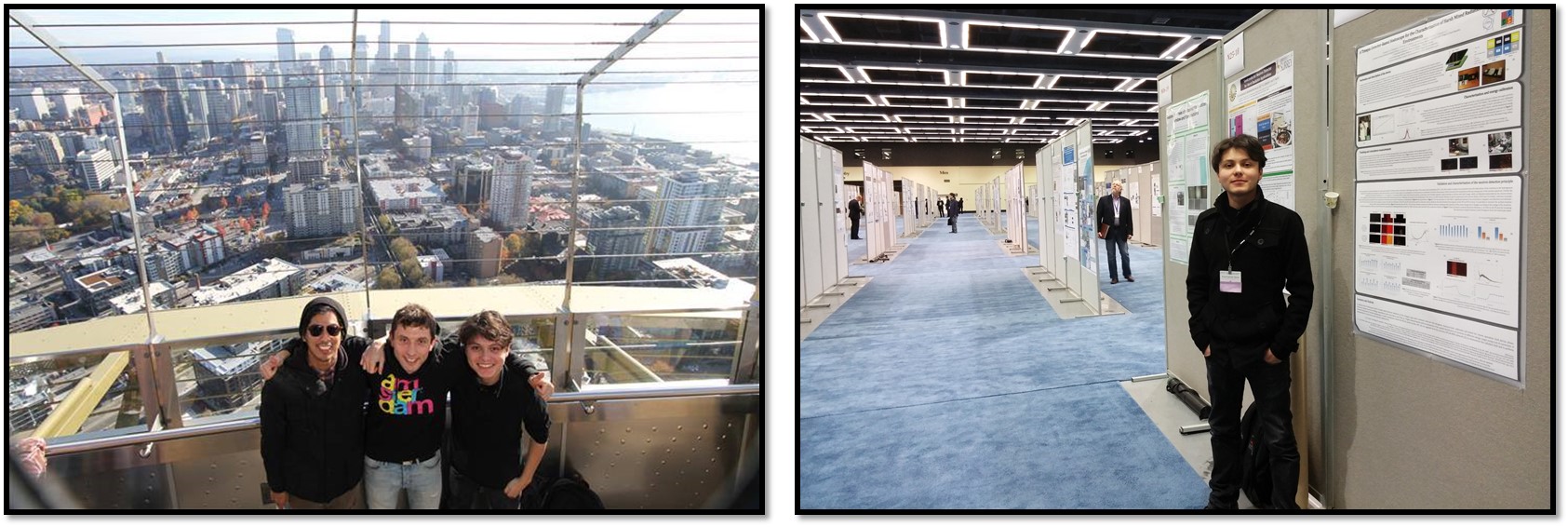
Activities on the 4th Quarter of 2013
November-December 2013
Experimental activities
Date: December, 2013
Training on skills for the assembly and characterization of the Timepix detection units for the ATLAS-MPX network upgrade: The upgrade of the ATLAS-MPX network to ATLAS-TPX consists on positioning 16 new Timepix-based detection units at strategic points inside and surrounding the ATLAS experiment at the LHC. As part of my tasks, I will assemble and characterize (equalize, calibrate in different radiation fields, etc.) all units, which basically consist on special arrays of two Timepix sensors with different thicknesses (300 and 500 ums.) facing each other, with a set of neutron convertor sections in between, and read-out by a common interface.
As a first step, I learned how to do the whole assembly of each layer, isolated components from the converters' frame and solded elements on the chipboards.

Meanwhile, I also learned how to wire-bond sensors from the chipboard to the chip itself.

And I got assigned my first USB read-out interface, which is a redesign of FITPix and had to be baptized provisionally:

It is still a long way to the top: Many sensors to deal with and a lot of testing and parameter setting for the whole network.
Date: November 7-12, 2013
Tests of the RISESAT micro-tracker EM at the IEAP Van de Graff accelerator: The Engineering Model of the Timepix-based micro-tracker to be placed at the RISESAT satellite in the following months (https://directory.eoportal.org/web/eoportal/satellite-missions/r/risesat) was taken to the VdG accelerator in order to evaluate its performance during long-term irradiation with neutrons and protons with energies in the range of MeV, and the coincidence between its two different layers. After data acquisition, the coincidence efficiency was quantified and some slight software and hardware issues were identified and corrected with the help from collaborators at the IEAP.
Here I show some photos of the setup and a pair of acquisitions from both layers working in Time of Arrival mode:

Date: December 2-6, 2013
New equalization for the EM: After some tests with the previous configuration, we decided to equalize both layers of the micro-tracker for a second time. Due to the requirements of the RISESAT Satellite the read-out interface is different from the one of a regular MPX, therefore, I had to learn how to change the EM firmware using an additional bridge device in order to be able to read the layers and do the equalizations through an USB connection and using Pixelman.

Date: November, 2013
Coincident Timepix devices in a 11B(p,Alpha)Alpha+Alpha reaction: Coincident Timepix devices operating with a "Mixed Mode" mask (One of every nine pixels was working in ToA mode, the other eight in TOT) were used to measure at different angles from the interaction point of a 11B(p,Alpha)Alpha+Alpha reaction in order to test the performance of such setting for this type of measurements. I analyzed data from different configurations based on the experience from my Master's Thesis.
Here I show some photos of the setup (As measured by Dr.Ing. Carlos Granja from the IEAP of the CTU) and some preliminary data analysis:

Date: December, 2013
Access to data from Timepix devices at the ISS and Proba-V Satellite (SATRAM): I learned how to access the daily updated data from five Timepix devices at the ISS and one at the SATRAM unit at Proba-V Satellite.
Even though it is exciting and promising to have access to this data, and I understand the events that they are detecting from my previous experience with Timepix detectors...I still have a lot to learn about radiation in space in order to analyze this data properly.
The Truth is -already- Out There:

Activities on the 1st Quarter of 2014
January-March 2014
Experimental activities
Date: January-March, 2014
Assembly, characterization and calibration of the ATLAS-TPX devices: This quarter was mainly dedicated to tune and study all the parameters for an optimal and long-term operation of all the radiation-hard devices inside the ATLAS cavern for the next years.
A proper selection of sensors was made, and after their equalization their noise level was revised and improved.
At the end of January, a measurement campaign at the Heidelberg Ion Therapy Center was carried out in collaboration with ESR9 and other colleagues from the IEAP during beamtime provided by ARDENT. In that opportunity, the performance, synchronization and tracking capabilities of the ATLAS-TPX (specially focusing on its operation in "Time of Arrival"mode) were tested for protons, helium, carbon and oxygen ions with energies in the range from 80 to 430 MeV per nucleon and at different incidence angles. CR39 detectors were placed close to the sensors for intercomparison.


Regarding the energy calibration of all detectors, fluorescence x-rays from three different materials and one radioactive AmIn source were used. Energy peaks and detector thresholds were chosen to suit the design of the devices and all variables involved in a long-term operation inside the intense radiation field at the ATLAS experiment. The following figures show the setup and calibration validation with different sources.


In parallel, different methods were tested for the deposition of Lithium Fluoride used as thermal neutron convertor in between sensors. After choosing the most efficient technique, LiF was deposited and weighted for all devices.

Date: January, 2014
Tests of the RISESAT micro-tracker EM: The RISESAT device was exposed to an Americium source in vacuum and ion beams at the Heidelberg Ion Therapy Center in both Time Of Arrival and Time Over Threshold mode.

Final device: The final design of the RISESAT micro-tracker is already available. It overcomes flaws identified at the EM stage. Its characterization and calibration will be performed in the future.
Activities on the 2nd Quarter of 2014
April-June 2014
Experimental activities
Date: April-June, 2014
Acquisition of data for all energy calibrations and other reference measurements: X-ray data acquisition for the calibration of all devices was finished in cooperation with ESR8. In addition, I/V measurements to estimate the leakage current of the assemblies and reference measurements of alpha particles were performed for intercomparison of the final calibrations from all devices.

Radiation hardness test at the Nuclear Science Institute, Rez (Czech Republic): Some partially malfunctioning Timepix sensors were assembled as an ATLAS-TPX device to perform a preliminary radiation hardness test of the devices when irradiated in a synchrotron facility at the Czech Nuclear Science Institute. .

Neutron Efficiency calibrations: All ATLAS-TPX devices were irradiated on both sides by thermal and fast neutrons from 241Am and 252Cf sources to determine the efficiency of convertor areas for neutron detection up to 4 MeV in each detector.

Sixteen ATLAS-TPX devices were taken to CERN for their installation inside the ATLAS cavern. One additional device is kept at the IEAP in Prague as reference for testing, evaluation of effects of future changes on operation conditions, and further characterization measurements which could be extrapolated to other devices.

...This is just starting.
Date: April 2014:
Measurements at the Heidelberg Ion Therapy Center: Support on the planning and execution of preliminary tests for a Timepix-based magnetic spectrometer. In addition, one ATLAS-TPX unit was placed as a parasite device during the measurements with different types of ions in order to test its behaviour after changes in the interface firmware and detector settings.

Date: February and May/June 2014
Introducing new researchers to the operation of Timepix devices: I trained PhD students from the University of Wollongong (Valentina Giacometti, Italian) and University of Montreal (Thomas Billoud, French) who visited the IEAP in Prague to learn about the capabilities, operation and calibration of Timepix devices. This experience will be helpful to their future research on proton therapy and monitoring of luminosity inside the ATLAS experiment.
p>Date: May 2014ARDENT training course: I attended a one-week training course organised for all ARDENT ESR's consisting of three modules: Technology Transfer, Project Management and Entrepreneurship. The first module was given by CERN Knowledge and Technology Transfer group, the second by STS SAUTER Training and Simulation S.A., the third by the Said Business School at Oxford, UK.
Date: May 2014
Outreach activity at the 60th Anniversary celebration of CERN: I was one of the six ARDENT ESRs presenting the Timepix device to visitors at the Radiation Protection stand in the framework of CERN's 60th Anniversary Celebrations.

Activities on the 3rd Quarter of 2014
July - September 2014
Activities
Date: 20 - 27 July, 2014
First visit for the installation and test of the ATLAS-TPX devices inside the ATLAS cavern: 12 out of 16 devices were set in the planned positions with the collaboration of colleagues from the IEAP CTU. Cabling was available only for one of them, which was used for testing of operational values in the new dedicated "ATLASPIX" interface.

Date: 4 - 5 August, 2014
Measurement at the IEAP VdG accelerator: Together with ESR9, we irradiated the reference ATLAS-TPX device with quasi-monochromatic 16.7 MeV neutrons from a D-T reaction while it rotated from one of its sides to the other one to estimate its detection and geometric efficiencies at this energy level.

Date: 15 - 21 September, 2014
Second visit for the installation and test of the ATLAS-TPX devices inside the ATLAS cavern: In this ocassion, the cabling for 9 devices was available and it was possible to test their response with a tuned prototype of the dedicated interface.

Date: 30 June - 4 July 2014
NDRA 2014, Summer School on Neutron Detectors and Related Applications: I attended this Summer School organized by the Industrial Engineering Department of the University of Trento. The aim of the school was to illustrate principles, methodologies and the most recent applications of neutron detection technologies. In particular, the school dealt with neutron-matter interaction principles suitable to neutron detection, materials for neutron detectors, signal processing, Monte Carlo simulation codes and interdisciplinary applications of neutrons.
Date: 10 - 22 August, 2014
Wilhelm and Else Heraeus Physics School on "Ionizing Radiation and Protection of Man": This Physics School (Organized by the German Physics Society and the Helmholtz Institute Munchen) consisted on classes and some practical activities about three main topics: "Radiation Physics and Dosimetry", "Radioecology", and "Radiation Epidemiology" focusing at the end on the assessment of Risk vs. Dose factors in different situations. All talks were given by renown scientists on the area of radiation monitoring and regulation from all over the world.

Date: 17 September, 2014
Medipix Meeting at CERN: I attended the Medipix meeting, where I was updated about the status of the Medipix3, Timepix3, Timepix2, read-out interfaces and research projects of other members of the Medipix Collaboration.
Date: 11 - 13 September, 2014
8th European Conference on Medical Physics: I attended this conference organized by the European Federation of Organizations for Medical Physics. Researchers from all over Europe and some research centres and hospitals from the USA presented their contributions in two parallel sessions. My assistance was focused on talks related to Quality Assurance in Radiotherapy, Monte Carlo simulations for Hadron Therapy and Dosimetry. My poster contribution "Characterization of secondary radiation in ion beam therapy using a mixed pixel operation mask" was available all the time in digital form for the participants and I did a short presentation of it in the e-poster presentation section.
Activities on the 4th Quarter of 2014
October - December 2014
Activities
Date: October, 2014
Preparation of detectors for the MoEDAL experiment: Three Timepix detectors equipped with 1 mm thick silicon sensors were characterized and calibrated for a network configuration (Similar to ATLAS-TPX) installed around the interaction point of the MoEDAL experiment at the LHC. One of them was covered with neutron converters and we performed measurements to calculate its efficiency at the Czech Metrology Institute in Prague with thermal and 252Cf neutrons.

Date: 26 October, 2014
Parasite measurement at the DKFZ: After assisting to a symposium organized by the DKFZ in Heidelberg, I was able to participate as a parasite experiment in a beam time dedicated to the Heavy Ion Therapy group. Together with collaborators from the IEAP CTU, we exposed some Timepix and Timepix3 detectors with unusual sensors to light ion beams.

Date: 18 - 30 November, 2014
Tests, characterization and calibration of Timepix3: Timepix3 is a new detector of the Medipix family. It allows simultaneous energy and time of arrival measurements with a higher time resolution than regular Timepix devices. As this is a very new detector, its features are still under test and many things (Even the acquisition software) are under development. Together with ESR9 and ESR2, we worked on the understanding of the data formats from the new software, tested the USB interface, characterized the threshold of the detector and acquired x-ray data that we used to calibrate the response in Time Over Threshold mode for two detectors. These two devices were taken for Time Of Flight measurements at Los Alamos National Science Centre in the United States.
Date: 22 - 25 October 2014
Interdisciplinary Symposium ''Precision, Speed and Flexibility: New radiation detection methods for ion beam radiotherapy'': I attended this symposium together with other colleagues from IEAP CTU. The symposium covered topics in detection techniques for quality assurance of ion beams in ion therapy, visualisation of moving organs, beam monitoring in the patient and spectroscopy of secondary ions for radiobiology. Many results from the collaboration between the Ion Therapy Group at the DKFZ and the IEAP CTU in the application of Timepix detectors for such tasks were presented.
Date: 28 September - 3 October, 2014
3rd ARDENT Meeting and Workshop: This was my first official ARDENT meeting with all other ESRs and members of the boards. In the first two days, Early Stage Researchers (Including myself) presented a report on their activities during the last year in the framework of the ARDENT project. In addition, a poster session was held. During the time spent at IBA, we held practical sessions on Quality Assurance for conventional radiotherapy and radiology (Relative and absolute dosimetry, planning systems, dose monitoring with ionization chambers for x-ray imaging) and attended talks regarding applications of semiconductor detectors in the framework of the aims of the project.

Date: 7 - 17 November, 2014
2014 IEEE Nuclear Science Symposium and Medical Image Conference -21st Symposium on room-temperature semiconductor x-ray and gamma ray detectors-: I attended this conference and presented the contribution "Radiation-Hard Timepix Detector-Based Hodoscope for the Characterization of Harsh Mixed Radiation Environments" in the "Radiation Damage Effects and Radiation Hard devices" poster session of the event. This poster contained information about the coincidence tests, characterization, calibration and neutron detection efficiency of the devices assembled for the ATLAS-TPX network. In addition, I attended interesting talks regarding Medipix devices, testing of CdTe and CZT sensors, instrumentation for space applications and pixel semiconductor detectors.


